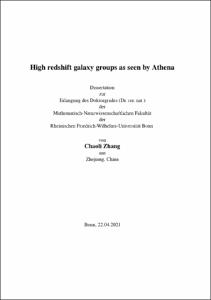Zhang, Chaoli: High redshift galaxy groups as seen by Athena. - Bonn, 2022. - Dissertation, Rheinische Friedrich-Wilhelms-Universität Bonn.
Online-Ausgabe in bonndoc: https://nbn-resolving.org/urn:nbn:de:hbz:5-64903
Online-Ausgabe in bonndoc: https://nbn-resolving.org/urn:nbn:de:hbz:5-64903
@phdthesis{handle:20.500.11811/9524,
urn: https://nbn-resolving.org/urn:nbn:de:hbz:5-64903,
author = {{Chaoli Zhang}},
title = {High redshift galaxy groups as seen by Athena},
school = {Rheinische Friedrich-Wilhelms-Universität Bonn},
year = 2022,
month = jan,
note = {The first massive galaxy groups in the Universe are predicted to have formed at redshifts well beyond two. Baryonic physics, like stellar and active galactic nuclei (AGN) feedback in this very active epoch, are expected to have left a strong imprint on the thermo-dynamic properties of these early galaxy groups. Therefore, observations of these groups are key to constrain the relative importance of these physical processes. However, current instruments are not sensitive enough to detect them easily and characterize their hot gas content.
In this work, we quantify the observing power of the Advanced Telescope for High ENergy Astrophysics (Athena), the future large X-ray observatory of the European Space Agency (ESA), for discovering and characterizing early galaxy groups at high redshifts. We also investigate how well Athena will constrain different feedback mechanisms.
We used the SImulation of X-ray TElescopes (SIXTE) simulator to mimic Athena observations, and a custom-made wavelet-based algorithm to detect galaxy groups and clusters in the redshift range 0.5≤z≤4. We performed extensive X-ray spectral fitting in order to characterize their gas temperature and X-ray luminosity. In the simulations and their analysis, we took into account the main Athena instrumental features: background, vignetting, and point spread function degradation with off-axis angle, as well as all X-ray foreground and background components including a realistic AGN flux distribution. Different physically motivated thermo-dynamical states of galaxy groups were simulated and tested, including central AGN contamination, different scaling relation models (luminosity evolution), and distinct surface brightness profiles. Also, different Athena instrumental setups were tested, including both 15 and 19 mirror rows and the applied optical blocking filter.
In the deep Wide Field Imager (WFI) survey expected to be carried out during part of Athena’s first four years (the nominal mission lifetime) more than 10,000 galaxy groups and clusters at z≥0.5 will be discovered. We find that Athena can detect ~20 high-redshift galaxy groups with masses z≥2, and almost half of them will have a gas temperature determined to a precision of T/T ≤ 25%.
We demonstrate that high-redshift galaxy groups can be detected very efficiently as extended sources by Athena and that a key parameter determining the total number of such newly discovered sources is the area on the sky surveyed by Athena. We show that these observations have a very good potential to constrain the importance of different feedback processes in the early universe because of Athena’s ability not only to find the early groups but also to characterize their hot gas properties at the same time.},
url = {https://hdl.handle.net/20.500.11811/9524}
}
urn: https://nbn-resolving.org/urn:nbn:de:hbz:5-64903,
author = {{Chaoli Zhang}},
title = {High redshift galaxy groups as seen by Athena},
school = {Rheinische Friedrich-Wilhelms-Universität Bonn},
year = 2022,
month = jan,
note = {The first massive galaxy groups in the Universe are predicted to have formed at redshifts well beyond two. Baryonic physics, like stellar and active galactic nuclei (AGN) feedback in this very active epoch, are expected to have left a strong imprint on the thermo-dynamic properties of these early galaxy groups. Therefore, observations of these groups are key to constrain the relative importance of these physical processes. However, current instruments are not sensitive enough to detect them easily and characterize their hot gas content.
In this work, we quantify the observing power of the Advanced Telescope for High ENergy Astrophysics (Athena), the future large X-ray observatory of the European Space Agency (ESA), for discovering and characterizing early galaxy groups at high redshifts. We also investigate how well Athena will constrain different feedback mechanisms.
We used the SImulation of X-ray TElescopes (SIXTE) simulator to mimic Athena observations, and a custom-made wavelet-based algorithm to detect galaxy groups and clusters in the redshift range 0.5≤z≤4. We performed extensive X-ray spectral fitting in order to characterize their gas temperature and X-ray luminosity. In the simulations and their analysis, we took into account the main Athena instrumental features: background, vignetting, and point spread function degradation with off-axis angle, as well as all X-ray foreground and background components including a realistic AGN flux distribution. Different physically motivated thermo-dynamical states of galaxy groups were simulated and tested, including central AGN contamination, different scaling relation models (luminosity evolution), and distinct surface brightness profiles. Also, different Athena instrumental setups were tested, including both 15 and 19 mirror rows and the applied optical blocking filter.
In the deep Wide Field Imager (WFI) survey expected to be carried out during part of Athena’s first four years (the nominal mission lifetime) more than 10,000 galaxy groups and clusters at z≥0.5 will be discovered. We find that Athena can detect ~20 high-redshift galaxy groups with masses z≥2, and almost half of them will have a gas temperature determined to a precision of T/T ≤ 25%.
We demonstrate that high-redshift galaxy groups can be detected very efficiently as extended sources by Athena and that a key parameter determining the total number of such newly discovered sources is the area on the sky surveyed by Athena. We show that these observations have a very good potential to constrain the importance of different feedback processes in the early universe because of Athena’s ability not only to find the early groups but also to characterize their hot gas properties at the same time.},
url = {https://hdl.handle.net/20.500.11811/9524}
}






